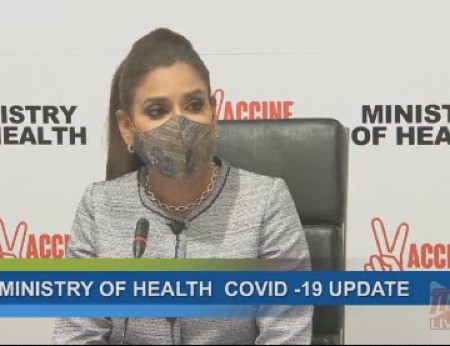PORT OF SPAIN, Trinidad – Trinidad and Tobago is recording a decline in the number of patients being treated for the coronavirus (COVID-19) pandemic, but health officials warn that it is still too early for people to disregard the various protocols put in place to stem the spread of the virus that has killed 3, 412 people and infected 112, 000 over a two year period.
 Principal Medical Officer – Institutions, Dr Maryam Abdool-Richards (CMC Photo)In its latest bulletin on Tuesday, the Ministry of Health reported eight deaths and 470 positive cases, which put the number of active cases to 19, 587. There are 487 patients in hospitals here.
Principal Medical Officer – Institutions, Dr Maryam Abdool-Richards (CMC Photo)In its latest bulletin on Tuesday, the Ministry of Health reported eight deaths and 470 positive cases, which put the number of active cases to 19, 587. There are 487 patients in hospitals here.
Principal Medical Officer – Institutions, Dr Maryam Abdool-Richards, speaking at the news conference of the Ministry of Health, told reporters that there had been a decline in the number of persons being treated at the Accident and Emergency departments and at hospitals across the country.
She said that the occupancy at the parallel healthcare system now stands at 53 per cent, represented by 477 patients, of which 383 are in hospital and 94 in step-down facilities.
“Yesterday there were 487 patients, and today we have noted 10 less patients. Over the last nine days, we have plateaued in terms of the overall occupancy between 53 and 55 per cent. This is the first time we have noticed a plateau in overall occupancy since the onset of the increased hospitalization on October 19, and that is over 106 days.
“We noticed that slow decline starting about 42 days ago and we have seen a nine-day plateau. We are hopeful that we will continue to see a decreasing trend,” she said, adding that the 10 Accident and Emergency departments, were currently treating 36 patients, five of whom requiring Intensive Care Unit treatment.
“Again, over the last 42 days, we have noticed a decline, which is slow but still a decline, in the number of patients being treated in the Accident and Emergency departments. Ladies and gentlemen, these trends are indeed promising, however, we must practice a tight balance of cautious optimism versus premature comfort.
“We now have the highly transmissible Omicron variant in our midst, and even though we’re seeing a decrease and a lowering of the national occupancy levels, we continue to notice some trends that are quite concerning,” the senior medical official said, adding however that the ICU level occupancy continues to be high.
“This morning, 57 out of 80 available ICU beds, representing an occupancy level of 73 per cent, are filled,” she said, adding that at the high acuity hospitals where the most ill patients are treated, there continue to have high occupancies, all in excess of 85 per cent.
“This means that persons who contract Covid-19 and require hospitalization, are often in a severe or critical medical condition, and that increases their risk of being admitted into the ICU, and of course, gives them less of a chance in terms of recovery.”
Dr. Abdool-Richards told reporters as it stands now, approximately 85 per cent of COVID victims in the parallel healthcare system are not fully vaccinated, which is a trend that has been consistent the past seven months.
“Globally, every country continue to struggle with this unrelenting virus, and we all continue in Trinidad and Tobago to adapt our management in terms of in tandem with the clinical realities and the epidemiology of this virus.”
She said she is also hoping that the members of the population will seek early treatment for COVID-19 as oppose to a reliance on therapies and medications that are not World Health Organization (WHO)approved so as to have a better chance of survival,.
“Again, we respect your choices but the evidence has indicated that if persons come to the hospitals earlier when they start experiencing symptoms, they have a greater chance of recovery. Vaccination continues to be a safe, effective and proven measure in reducing the risk of being hospitalized and requiring ICU level care if one contracts COVID.”
She said that vaccination is proven to reduce the transmissibility of COVID-19 especially to those of our relatives and friends who may have high risk factors or who cannot be immunized at this point, such as young children.
“Vaccination is an additional layer of protection with in line and in conjunction with the 3Ws that we have continued to exercise and practice over the last two years,” she told reporters.


